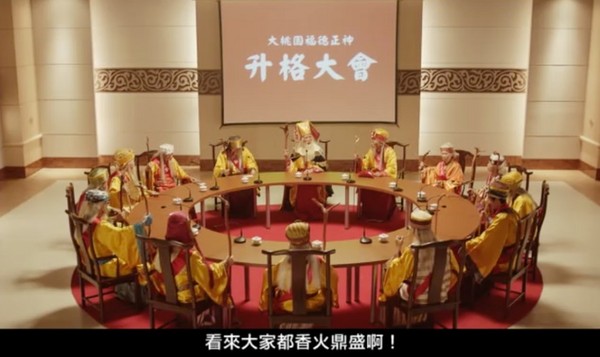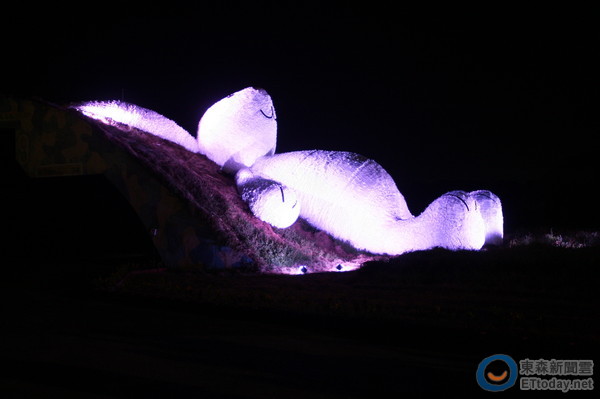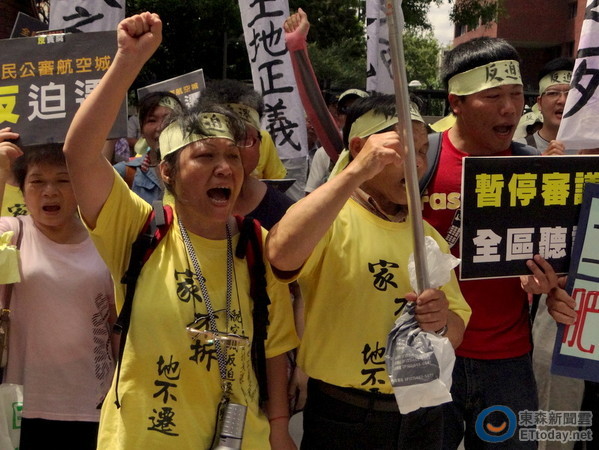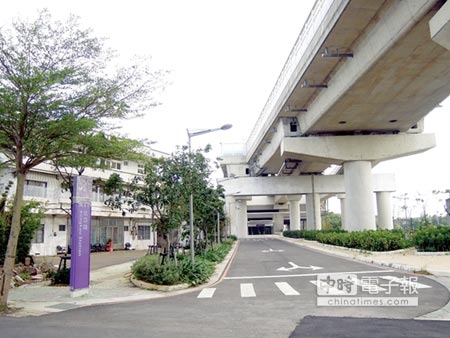Communities facing around Taiwan's Taoyuan Airport are facing huge land grabs for a vast airport city that will line the pockets of powerful officials, politicians and developers, but leave them with nothing, writes Rose Bridger. Now, faced with official abuse and police brutality, they are fighting back with street protests and art proje
Authorities are pursuing land acquisition in the absence of clear plans for a viable project, clear evidence that the Aerotropolis is a pretext for a land grab.
Taoyuan Airport, serving the Taiwan's capital city of Taipei on the northern tip of the island, is not unusual in planning expansion: A third runway and passenger terminal are planned.
But around the airport, government and big businesses are pursuing a far larger development: a megaproject called an 'aerotropolis', or airport city. Phased commercial, industrial and residential development is envisaged over an area totalling over 4,700 hectares.
The scheme encompasses a tourist resort with hotels and theme parks, conference and exhibition space, convention centres, business premises such as offices, R&D facilities and assembly plants plus accommodation for 300,000 people.
The government intends to
expropriate most of the site, over 3,700 hectares, mostly consisting of highly fertile farmland, from residents and landowners. There are 15,000 houses in this area and 46,000 residents face losing their homes and land.
Many of these people do not wish to give up their property for the project and the government's land acquisition procedures violate land rights enshrined in Taiwan's constitution
An animated
promotional video depicts the planned construction of the Aerotropolis. Identikit rectangular buildings metastasize outwards from the airport. Cultural facilities like convention and exhibition centres are graced with more interesting curved facades.
Urbanisation sprawls outwards as if expanding into nothing; the film makes no reference to the farmland and villages that would be destroyed by bulldozers.
Lining roads with trees, planting roofs with grass and shrubs, and a host of superficial environmentally friendly initiatives such as waterways, trains and bicycles and use of renewable energy, are just
green garnish.
Loss of agricultural land and damage to ecosystems would be irrevocable and the guiding principle of the Aerotropolis plan is locking in fossil fuel intensive aviation dependency, and the consequent high level of greenhouse gas emissions.
Protests and police brutality
Affected residents who do not want to leave, and the civic groups and activists supporting them, have held a multitude of protests against compulsory land expropriation, calling for fair, open public hearings.
In December 2013 protesters were
refused admission to a meeting deciding whether the government would seize land for the Aerotropolis project. Some tried to climb over the wall but police stopped them by holding onto their feet. A few protestors were then admitted, but were only given a few minutes to speak.
Chan Hsien-chang, spokesperson for the group established to oppose forced land expropriation, the Taoyuan Aerotropolis Self-Help Association, challenged the necessity of a third runway as passenger numbers are actually declining. He also questins the compulsory acquisistion of land for later stages of the project that are not scheduled to start for 20 years.
Opponents of the Aerotropolis are sceptical of the purported economic benefits to local people, contending that the project stands to benefit corporate interests, especially cronies linked to the government. One protester was forcibly removed by police officers.
The committee approved the land seizure, but affected residents only found out several hours later when they were questioned by reporters. One protestor performed a
striptease act to represent the stripping away of land from the people.
On 22nd June about
500 protesters marched through the city centre carrying yellow banners painted with the slogans they shouted:
"Anti-Greed & Corrupt",
"Anti-Eviction",
"Anti-Land Grab" and
"Public Hearing". Many also conveyed messages on T-shirts and headscarves.
On reaching the Taoyuan government offices they blocked traffic and performed a slow motion march walking a few paces then stopping to kneel and pray, repeating the sequence many times.
Project opponents excluded from the key planning meeting
Two days later a planning meeting about the Aerotropolis was held, but only a few stakeholders were allowed to attend, and they were permitted to speak for just three minutes. Wang Po-hsuan of Taiwan Association for Human Rights repeatedly asked for more residents to be
allowed to speak.
Her requests were denied and she and the other residents' representatives were dragged out of the meeting by police. Outside, protesters denied access to the meeting attempted to climb over barriers and a police blockade, but were pushed back.
On 17th July a group of residents, predominantly women, who may face forced eviction for Taoyuan Aerotropolis demonstrated outside the
Construction and Planning Agency, where a meeting was being held to review the project.
They held up maps showing how the expansion of the airport and Aerotropolis development is encroaching on homes and farmland.
Some residents explained they had lived on the land for many generations, worked for 20 years or more to earn sufficient money to build their homes, and that the compensation offered by the government would be a mere fraction of what would be required to buy another house in the area.
One of them, Lu Li-chin, questioned the necessity of land acquisition when large areas of government-owned land languish unused.
In September the Construction and Planning Agency came under fire from activists from the Snails Without Shells Alliance (a social movement demanding housing justice) for
fuelling land speculation.
Rural land is undervalued, far below its market value. But once this land is zoned for residential or commercial use, its value rockets upwards, lining the pockets of construction firms. Authorities are pursuing land acquisition in the absence of clear plans for a viable project, clear evidence that the Aerotropolis is a pretext for a land grab.
State-sanctioned robbery - for the profit of the few
Journalist
J Michael Cole explains how approval of land acquisition for Taoyuan Aerotropolis has trounced the democratic process.
Expedited hearings failed to adhere to standard protocols for such projects and community support organisations were alarmed to hear that, regardless of the outcome, if the government decided to demolish people's homes for the project, they would be unable to prevent it.
Cole also lambasted Taiwan's mainstream media outlets for lack of attention to the Aerotropolis project, and for failing to "join the dots" and recognise its pivotal role in an alarming wider picture of "government-sanctioned land grabs" benefiting investors and developers.
Land expropriation is a catalogue of injustices and a key human rights issue in Taiwan. The government repeatedly
abuses its powers of eminent domain (compulsory purchase) to seize homes and farmland, by means of 'zone expropriations' whereby large areas are subject to compulsory sale to the government for development projects.
Part of the land is used for infrastructure whilst other portions are sold to raise funds for construction or local government finance, topping up coffers that are depleted by low tax rates. At the beginning of 2014, the number of pending cases of 'zone expropriations' totalled 95, covering over 7,600 hectares.
Taoyuan Aerotropolis is by far the largest, accounting for nearly half of this land area. The threat of the biggest land expropriation in Taiwan's history is looming.
Professor Shih-Jung Hsu, Chair of Taiwan Rural Front and a member of the steering group of Taiwan Association for Human Rights describes land expropriations as
"robbery".
Affected people have just two choices, both of which leave them facing financial loss or ruin: they can accept a small amount of monetary compensation; or apply for alternative land ownership, whereby they have to accept a smaller area of land, frequently of poorer quality.
The government routinely expropriates more land than is required for the development projects. In some instances, odd, irregularly shaped areas are earmarked, targeting vulnerable communities least able to resist.
Demolition, dispossession & distress - the Dapu case
The worst case of state-sanctioned robbery occurred in the farming village of
Dapu in Miaoli County, in the northwest of the country. The government designated 156 hectares of land for an industrial complex but a substantial minority of homeowners did not want to relocate.
On 9th June 2010 villagers' rice fields were bulldozed by the government in a dawn raid, protected by hundreds of police, two weeks before the crops were due to be harvested. A citizen journalist filmed the incident, which drove an elderly woman whose land was destroyed to suicide.
Then last year, on 18th July 2013, police razed the homes of the last four remaining resisting households to the ground, including a home and pharmacy owned by Mr Chang Sen-wen.
The demolition took place while the matter was still being contested in court on a day when the home owners were absent - with supporters demonstrating outside the Presidential Office in Taipei.
Chang Sen-wen's wife, Peng Hsiu-chun was at the protest. When told that her
home had been demolished she screamed. She then collapsed to the ground after being hit with a police officers' shield.
Thuggish treatment of many protesters by police triggered civic disobedience all over Taiwan.
A month after the Dapu demolition nearly
10,000 protestors gathered outside the Presidential Office demanding reform of the Land Expropriation Act, a demonstration which escalated into a wider anti-government protest.
Banners proclaimed: "Yesterday Dapu was torn down, today the government will be torn down". Some activists sprayed the worlds "tear down" on a government building, the very words that are sprayed on homes marked for demolition. Then they occupied the Ministry of Interior for 20 hours.
But for many, the stress of fighting the Government is too much
Chang Sen-wen's mental and physical health had deteriorated during the ordeal that ended with his family home and business premises being demolished.
Two months later he was
found dead in an irrigation channel ditch close to where his home once stood. It remains unclear whether he committed suicide. Hundreds of people from all over Taiwan attended
Chang Sen-wen's funeral.
La A-yun, whose family's home land was acquired for an access road and park, killed himself by drinking toxic herbicide in November 2013. Relatives found his body when they when they returned home from participating in a protest rally against the Aerotropolis.
He was dismayed that his family had been forced to live on their ancestors' cemetery plots. One of his sons, Lu Wen-Chang, said that he was overwhelmed by the loss of his life's work and felt ashamed that he had been unable to protect the family inheritance.
Free Economic Pilot Zones - where land grabs are unstoppable
Big-business is not just salivating over the cheap land that the Aerotropolis promises to deliver them. The government intends to use the project to spearhead a corporation friendly low tax regime, by designating it as one of several
Free Economic Pilot Zones (FEPZs).
FEPZs would have a lax regulatory framework in order to facilitate industrialisation, foreign investment and international trade. The other locations would be major ports.
Plans for preferential treatment in the form of tax breaks are certainly comprehensive; tenants would be "exempt from customs tariffs, commodity taxes, business taxes".
Also, worryingly for land rights, Taiwan's policy-planning agency, the National Development Council, promises investors "more convenient land acquisition". The government's long term plan is to spread FEPZs "throughout the whole country", an enormous step towards turning Taiwan into a corporate playground.
Civic groups oppose FEPZs for taking
deregulation too far, favouring large foreign corporations over local small and medium-sized enterprises and eroding workers' rights.
FEPZs and the 'China connection'
There are also concerns that FEPZs are a 'back door' way of strengthening trade ties with China. Facilitating economic integration with Taiwan's neighbouring industrial superpower would downgrade the country's sovereignty.
The Taiwanese government is attempting to railroad FEPZs through the legislature after a student-led occupation movement in March derailed a trade pact between the two governments. There is particular concern that farmers would be trampled on by the free flow of goods.
Social movements have slammed the zone plan as a
"suicide pact" for Taiwan farmers, as their incomes are already low and lifting restriction on imports of agricultural commodities would be unfair competition due to lower labour and environmental costs in China.
J Michael Cole points out another legislative manoeuvre that has already increased China's control over the island. Under regulations that were passed in 2012
"China can participate in infrastructure projects and act as contractors."
China has wasted no time "zeroing in" on Taiwan's key sectors, he adds: "landmark infrastructure projects, the high-tech industry, commercial real estate, and logistics and transportation". The Taoyuan Aerotropolis project ticks all these boxes.
An alternative art festival
Campaigning to raise local and international awareness of the Taoyuan Aerotropolis scheme and the plight of affected people has been boosted by an extraordinarily creative and innovative
Aerotropolis Land Art Festival, held on farmland in the project area.
The event was organised by the local community and supporters in response to a government supported Land Art Festival on a disused military base adjoining Taoyuan Airport in September. Photographs of the main attraction, a 25 metre high '
Moon Rabbit' sculpture, were beamed around the world.
At the opening ceremony a small group of protesters attempted to submit a petition calling for a fair and open hearing. Their request was denied and they were
brutally removed by police. One woman was injured and hospitalised.
Two months later the community-based Aerotropolis Land Art Festival opened, celebrating the communities, farming and wildlife threatened with obliteration.
Famous bands performed and art installations were linked by a bicycle trail. Visitors hit back at the Aerotropolis, demolishing a model of it with wrecking balls covered in anti-government slogans.
The focal point was the 'Lost Bear' sculpture, symbolising the sadness of people who fear being uprooted. The height of a three-storey house, the bear's 'fur' was made from strips of cloth intricately folded around a wooden frame. Thousands of people flocked to the festival. It was so successful that its planned two-week duration was extended to four weeks.
Community-based art has proved a powerful force for engagement in a campaign that is of the utmost urgency. Land seizures for Phase 1 of Taoyuan Aerotropolis are scheduled to commence in 2015.
Campaigners attempting to stop forcible land expropriation are up against powerful vested interests. Taoyuan residents living under the shadow of displacement need worldwide support from movements for land justice, democracy and preservation of farmland.









